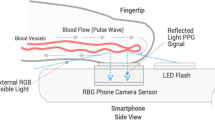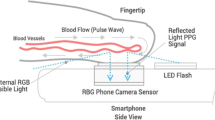Abstract
To provide information about the clinical relevance of blood pressure (BP) measurement differences between a new smartphone application (OptiBP™) and the reference method (automated oscillometric technique) using a noninvasive brachial cuff in patients admitted to the emergency department. We simultaneously recorded three BP measurements using both the reference method and the novel OptiBP™ (test method), except when the inter-arm difference was > 10 mmHg BP. Each OptiBP™ measurement required 1-min and the subsequent reference method values were compared to the values obtained with OptiBP™ using a Bland–Altman analysis and error grid analysis. Among the 110 patients recruited, OptiBP™ BP values could be collected on 61 patients (55%) and were included in the statistical analysis. The mean of differences (95% limits of agreement) between the reference method and the test method were − 0.1(− 22.5 to 22.4 mmHg) for systolic arterial pressure (SAP), − 0.1(− 12.9 to 12.7 mmHg) for diastolic arterial pressure (DAP) and − 0.3(− 18.1 to 17.4 mmHg) for mean arterial pressure (MAP). The proportions of measurements in risk zones A-E were 86.9%, 13.1%, 0%, 0%, and 0% for MAP and 89.3%, 10.7%, 0%, 0%, and 0% for SAP. In this pilot study conducted in stable and awake patients admitted to the emergency department, the absolute agreement between the OptiBP™ and the reference method was moderate. However, when BP measurements were made immediately after an initial calibration, error grid analysis showed that 100% of measurement differences between the OptiBP™ and reference method were categorized as no- or low-risk treatment decisions for all patients.
Trial Registration: ClinicalTrials.gov Identifier: NCT04121624.






Similar content being viewed by others
References
Elliott WJ. Systemic hypertension. Curr Probl Cardiol. 2007;32:201–59.
Williams B, Mancia G, Spiering W, et al. 2018 ESC/ESH Guidelines for the management of arterial hypertension: The task force for the management of arterial hypertension of the European Society of Cardiology and the European Society of Hypertension: The task force for the management of arterial hypertension of the European Society of Cardiology and the European Society of Hypertension. J Hypertens. 2018;36:1953–2041.
Patel AA. Developing and evaluating mhealth solutions for chronic disease prevention in primary care. Circulation. 2019;139:392–4.
Stojanova A, Koceski S, Koceska N. Continuous blood pressure monitoring as a basis for Ambient Assisted Living (AAL)—review of methodologies and devices. J Med Syst. 2019;43:24.
Ghamri Y, Proença M, Hofmann G, et al. Automated pulse oximeter waveform analysis to track changes in blood pressure during anesthesia induction: A proof-of-concept study. Anesth Analg. 2020;130:1222–33.
Schoettker P, Degott J, Hofmann G, et al. Blood pressure measurements with the OptiBP smartphone app validated against reference auscultatory measurements. Sci Rep. 2020;10:17827.
Saugel B, Grothe O, Nicklas JY. Error grid analysis for arterial pressure method comparison studies. Anesth Analg. 2018;126:1177–85.
Grothe O, Kaplan A, Kouz K, Saugel B. Computer program for error grid analysis in arterial blood pressure method comparison studies. Anesth Analg. 2020;130:e71–4.
Proenca M, Bonnier G, Ferrario D, Verjus C, Lemay M. PPG-based blood pressure monitoring by pulse wave analysis: Calibration parameters are stable for three months. Annu Int Conf IEEE Eng Med Biol Soc. 2019;2019:5560–3.
Ramsey M 3rd. Blood pressure monitoring: automated oscillometric devices. J Clin Monit. 1991;7:56–67.
Benmira A, Perez-Martin A, Schuster I, et al. From Korotkoff and Marey to automatic non-invasive oscillometric blood pressure measurement: does easiness come with reliability? Expert Rev Med Devices. 2016;13:179–89.
Stergiou GS, Palatini P, Asmar R, et al. Recommendations and Practical Guidance for performing and reporting validation studies according to the Universal Standard for the validation of blood pressure measuring devices by the Association for the Advancement of Medical Instrumentation/European Society of Hypertension/International Organization for Standardization (AAMI/ESH/ISO). J Hypertens. 2019;37:459–66.
Kaufmann T, Cox EGM, Wiersema R, et al. Non-invasive oscillometric versus invasive arterial blood pressure measurements in critically ill patients: A post hoc analysis of a prospective observational study. J Crit Care. 2020;57:118–23.
Juri T, Suehiro K, Uchimoto A, et al. Error grid analysis for risk management in the difference between invasive and noninvasive blood pressure measurements. J Anesth. 2021;35:189–96.
Kuck K, Baker PD. Perioperative Noninvasive Blood Pressure Monitoring. Anesth Analg. 2018;127:408–11.
Acknowledgements
All the clinicians and nurses from the emergency department.
Funding
This work was supported by the Department of Anesthesiology, Erasme Hospital, Brussels.
Author information
Authors and Affiliations
Contributions
All authors read and approved the final manuscript. OD: Designed the study, analyzed the data and drafted the final manuscript. AT: Analyzed the data and drafted the final manuscript. AJ: Collected the data and edited the final manuscript. LT, YZ, DC, VC, BA, JFK, PS: Analyzed the data and edited the final manuscript. AJ: Designed the study, collected and analyzed the data and drafted the manuscript.
Corresponding author
Ethics declarations
Conflict of interest
OD is consultant for Medtronic (Trévoux, FRANCE) and and Livanova (Châtillon, France). JFK is working for Biospectal SA, Lausanne, Switzerland. PS is an advisor of Biospectal SA, Lausanne, Switzerland. AJ is a consultant for Edwards Lifesciences (Irvine, California, USA). The other authors have no conflicts of interest to declare.
Additional information
Publisher's Note
Springer Nature remains neutral with regard to jurisdictional claims in published maps and institutional affiliations.
Rights and permissions
About this article
Cite this article
Desebbe, O., Tighenifi, A., Jacobs, A. et al. Evaluation of a novel mobile phone application for blood pressure monitoring: a proof of concept study. J Clin Monit Comput 36, 1147–1153 (2022). https://doi.org/10.1007/s10877-021-00749-2
Received:
Accepted:
Published:
Issue Date:
DOI: https://doi.org/10.1007/s10877-021-00749-2




